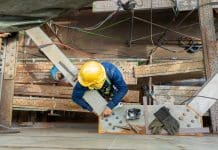Timber Development has unveiled a comprehensive Timber Skills Action plan, in partnership with Edinburgh Napier University, NMITE and the HCI Skills Gateway, aimed at equipping the UK construction industry with the necessary skills to increase the use of timber and achieve net zero targets. Chief executive Dave Hopkins discusses the thinking behind the plan
As the construction industry looks for pathways to net zero, timber is increasingly emerging as a leading contender to turn back the clock on carbon emissions. However, there are challenges ahead and a lack of appropriate skills in a workforce that remains addicted to concrete and steel is the first area that needs to be addressed.
The advantages of overcoming this skills gap are evident, from restoration and retrofit to new build solutions and infrastructure. With a vast array of products and timber systems now available, with advanced treatments for durability and fire performance, advanced timber technologies can respond to many of the sector’s needs.
Moreover, modern engineered timber products from sustainably managed forests provide an existing carbon capture solution, sequestering carbon and storing it in the built environment (676kg of CO2 per m3) while providing additional environmental benefits in the form of biodiverse forests. Meanwhile, housing constructed using panelised timber frames have approximately half the embodied carbon of traditional masonry builds.
However, increased use of timber in construction will require a workforce equipped to make the best of this renewable resource.
Too few built environment professionals, from architects and specifiers to engineers and operatives, have the skills, knowledge and confidence to incorporate timber into building designs. All these roles need a new approach to education in the future and all their qualifications need to include an improved understanding of innovation in modern timber construction.
Current graduates are largely unaware of new technical knowledge, such as manufacturing line approaches to building or how modern products like CLT can replace carbon-intensive concrete and steel to deliver long-span structures and higher-rise buildings. However, employers require more skilled personnel to ensure responsible timber design and delivery.
An opportunity for a more collaborative approach
Currently, the UK construction industry employs 3.1m people. Yet the skills crisis means the industry needs at least 350,000 more full-time workers over the next decade to deliver ambitions for the built environment. This is both an issue and an opportunity to change the way we do things to support a greener future for construction.
The timber industry consistently calls for improved education. As the skills gap is addressed, we want to see a wider understanding of timber’s attributes, potential uses and impacts on productivity, environmental and whole-life cost benefits, and overall structural and material performance.
To achieve this, the education of future built environment professionals needs to instil collaborative practices and an improved understanding of the net zero challenge. There should be more meaningful, practical work experience emphasising SME engagement. A collaborative approach to the design process is necessary, taking note of the interdependences of building, fire and structural performance.
In short, the skills needed for responsible design and construction provide the perfect platform for the greater use of timber. Together, this will provide us with more environmentally friendly and thermally efficient homes and buildings – and the corresponding comfort, health and wellbeing benefits to all building users.
The Timber Skills Action Plan
To help achieve this, we have published an industry-agreed timber technology engineering design competency framework within our Timber Skills Action Plan in partnership with the HCI Skills Gateway.
The Timber Skills Action Plan provides an industry-agreed breakdown of the skills and knowledge required for building with timber and a definition of what a skilled construction worker should know and be able to do when building in timber. It covers everything from design and specification, manufacture, construction, building and science materials, health and safety regulations & legislation, sustainability and the circular economy.
The goal is to aid the development of training programmes and support Continuing Professional Development (CPD) progression, helping built environment professionals to confidently incorporate timber into building designs.
The framework already underpins a set of short, practical courses developed by NMITE’s Centre for Advanced Timber Technology (CATT) in partnership with TDUK. The Timber TED (Technical Engineering & Design) courses provide comprehensive and flexible training for modern timber construction methods, enabling professionals to upskill and reskill in this critical area.
Timber is lightweight, easily workable and can be processed efficiently using Modern Methods of Construction, reducing waste and improving productivity. It can provide solutions for affordable, energy-efficient housing, national retrofit targets and net zero public sector buildings. With the launch of the Timber Skills Action Plan, we are one step closer to making this happen.
Dave Hopkins
Chief execu tive
tive
Timber Development
Tel: +44 (0)20 3205 0067

















